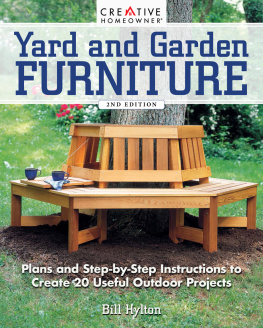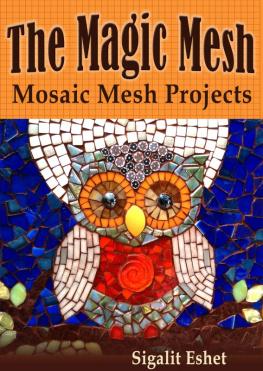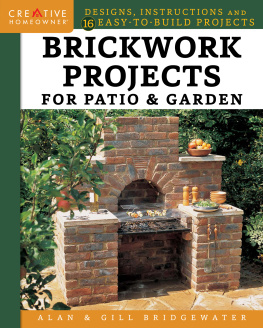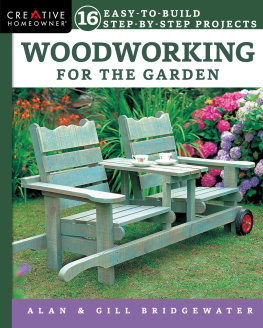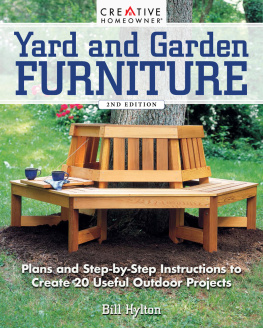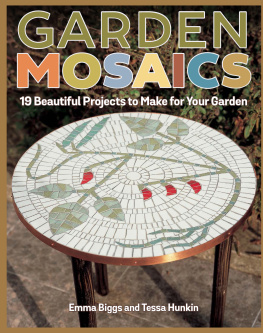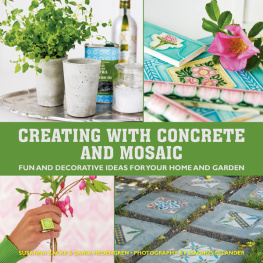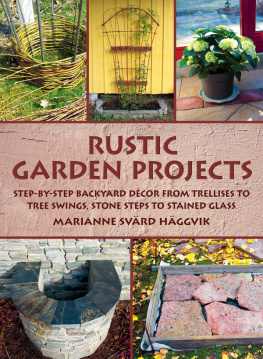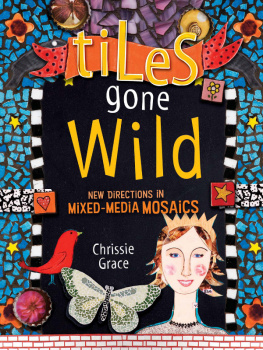
Mosaic Garden Projects
Add Color to Your Garden with Tables, Fountains, Birdbaths, and More
by Mark Brody
with Sheila Ashdown
with photographs by Justin Myers
Timber Press
Portland / London
page 1: A shimmering dragonfly combines several kinds of glass to stunning effect.
pages 23: A mosaicked pagoda offers a bright and modern take on the traditional pagoda form.
The information in this book is true and complete to the best of our knowledge. All recommendations are made without guarantee on the part of the author or Timber Press. The author and publisher disclaim any liability in connection with the use of this information. Mention of trademark, proprietary product, or vendor does not constitute a guarantee or warranty of the product by the publisher or authors and does not imply its approval to the exclusion of other products or vendors.
Copyright 2015 by Mark Brody and Sheila Ashdown. All rights reserved.
Published in 2015 by Timber Press, Inc.
Photo credits appear on .
Illustrations by Kate Francis
Illustration by Sarah Loveday, courtesy of Andy Vernon
Templates by Mark Brody
The Haseltine Building
133 S.W. Second Avenue, Suite 450
Portland, Oregon 97204-3527
timberpress.com | 6a Lonsdale Road
London NW6 6RD
timberpress.co.uk |
Book design by Breanna Goodrow
Library of Congress Cataloging-in-Publication Data
Brody, Mark, author.
Mosaic garden projects: add color to your garden with tables, fountains, birdbaths, and more/by Mark Brody; with Sheila Ashdown; with photographs by Justin Myers.
pages cm
Includes index.
ISBN 978-1-60469-682-0
1. GardensDesign. 2. Mosaics. 3. Color in design. 4. Garden ornaments and furniture. I. Ashdown, Sheila. II. Title.
SB473.B7226 2015
712dc23
2014020734
A catalog record for this book is also available from the British Library.
To my lovely wife, Jo, who can always put the pieces together quicker than I can. Im just so grateful to be near your infectious charm and spontaneity.
To my mother, Peggy, whose artistic side has fully blossomed and who has always been the biggest fan of my creativity.
M. B.
Contents
Preface
M y interest in mosaics grew out of my adventure with building a house. My wife, Jo, and I built our starter house out of tires, tin cans, and adobe brick in the high desert of New Mexico. We built an Earthshipa house made out of recycled materialsand learned which surfaces could stand up to the ever-changing elements of the seasons. We tiled our adobe walls (a failure), bathroom showers (very inspiring), and kitchen countertops (very practical), and soon mosaics spread to our homes outdoor features as well. Tiles provided an ornamental and protective surface to the form underneath and, in our garden, became a colorful accent that could outlast any coat of paint.
A wealth of materials and surfaces can be covered with mosaic, and knowing the possibilities of mosaic as well as the limitations is vital to confidently making an art piece for the outdoors. I taught myself how to mosaic, learning techniques from one project to the next, and I relish the puzzlelike quality of mosaicsputting many pieces together to make a whole. Ive been teaching mosaic for more than 12 years, and in each student I see an innate fascination with putting together shapes and color in a unique way. In this book, I provide an introduction to the tools, materials, designs, and basic methods or techniques for a variety of projects that will get you started. While there are specific techniques to laying out a mosaic, there is also room for innovation. After completing your first two or three mosaic projects, you will likely develop a style of your own.
Mosaic and garden design have similar characteristics. They are each made of an assembly of pieces laid out in a certain way. You can give 20 gardeners the same list of plants, and they will each design a garden in their own style. So, find a mosaic you would like to make and dont worry if you change a color here or a size therethis book is just planting the seeds for your next garden creation.

This ambitious project is well worth the effort. Your senses will delight in the whimsical design and flowing cascade of water.
Plant Some Art in Your Garden
M osaics provide a creative finishing touch to any garden. No matter the season, mosaic adds an element of delight year-round. When your garden is in bloom, the mosaic recedes, letting Mother Nature have her time to shine. And in the winter months, mosaics emerge to give some much-needed life to a dormant landscape.
What sets mosaic apart from most other art forms is its functionality and endurance. Though mosaics are pleasing to the eye, they can be so much more. Even ordinary objects can become extraordinary. The projects in this book feature planters, tables, a birdbath, fountains, and more. Of course, a mosaic doesnt need to have an explicit purpose. After all, does a flower need a reason to exist? Not at all. Its beauty is reason enough.
Whats more, these lovely art pieces are built to last for years outdoors with hardly any upkeep. In fact, there still exist preserved mosaics that were created in 3000 BCE. Talk about a perennial! Because they are made from building materialsespecially those borrowed from the tiling trademosaic has just the right blend of beauty and strength to make it an art form that can go from indoors to outdoors. Composing a mosaic from hundreds of small pieces is a painstaking process, but its a worthwhile investment to create something that will possibly last a lifetime. This durability gives you the freedom to push the boundaries of art and how you can enjoy it. Rather than being hidden away indoors, your garden mosaic can live outside and become part of the landscape.
Mosaic art has deep roots in historyall the way back to the fourth century BCE. Mosaic was born because, given the tools available at the time, craftsmen had to work with smaller materials to lay floors. Some cultures began to add an artistic element to something that was otherwise just purely functional. And then they added it to the walls! As tools evolved, the emphasis grew toward the artistry and craft. Mosaic became less necessary, but more beautiful. If youre a gardener, you can likely appreciate the opportunity to participate in an art form that has been cultivated and tended across centuries.
If youre new to mosaic, rest assured that, if youre a gardener, youre already bringing a necessary set of skills to the process. Mosaic has many similarities to garden design, because each uses similar components. The composition of a garden, as well as any mosaic, is a product of its colors, shapes, sizes, and layout of materials. Experience teaches the gardener to look at the big picture and know which plants work well placed next to another plant. Similarly, the mosaic artist knows when to keep color tones the same and when to punch out a strong contrast. Every new piece laid out, whether its a plant in the garden or a tile in the mosaic, is part of the larger design.
Outside is where art should live, amongst us.
BANKSY
The challenge of making mosaics for the garden is to learn the proper materials and techniques to make something creative and enduring. This book is loaded with 25 exciting mosaic projects with step-by-step directions, photographs, and templates, as well as comprehensive information about materials and techniques to help you create beautiful, long-lasting artwork for your garden.
Next page

